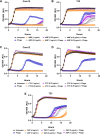Lytic bacteriophages facilitate antibiotic sensitization of Enterococcus faecium
- PMID: 33649110
- PMCID: PMC8092871
- DOI: 10.1128/AAC.00143-21
Lytic bacteriophages facilitate antibiotic sensitization of Enterococcus faecium
Erratum in
-
Correction for Canfield et al., "Lytic Bacteriophages Facilitate Antibiotic Sensitization of Enterococcus faecium".Antimicrob Agents Chemother. 2025 Aug 6;69(8):e0059025. doi: 10.1128/aac.00590-25. Epub 2025 Jul 8. Antimicrob Agents Chemother. 2025. PMID: 40626887 Free PMC article. No abstract available.
Abstract
Enterococcus faecium, a commensal of the human intestine, has emerged as a hospital-adapted, multi-drug resistant (MDR) pathogen. Bacteriophages (phages), natural predators of bacteria, have regained attention as therapeutics to stem the rise of MDR bacteria. Despite their potential to curtail MDR E. faecium infections, the molecular events governing E. faecium-phage interactions remain largely unknown. Such interactions are important to delineate because phage selective pressure imposed on E. faecium will undoubtedly result in phage resistance phenotypes that could threaten the efficacy of phage therapy. In an effort to understand the emergence of phage resistance in E. faecium, three newly isolated lytic phages were used to demonstrate that E. faecium phage resistance is conferred through an array of cell wall-associated molecules, including secreted antigen A (SagA), enterococcal polysaccharide antigen (Epa), wall teichoic acids, capsule, and an arginine-aspartate-aspartate (RDD) protein of unknown function. We find that capsule and Epa are important for robust phage adsorption and that phage resistance mutations in sagA, epaR, and epaX enhance E. faecium susceptibility to ceftriaxone, an antibiotic normally ineffective due to its low affinity for enterococcal penicillin binding proteins. Consistent with these findings, we provide evidence that phages potently synergize with cell wall (ceftriaxone and ampicillin) and membrane-acting (daptomycin) antimicrobials to slow or completely inhibit the growth of E. faecium Our work demonstrates that the evolution of phage resistance comes with fitness defects resulting in drug sensitization and that lytic phages could serve as effective antimicrobials for the treatment of E. faecium infections.
Copyright © 2021 American Society for Microbiology.
Figures







Similar articles
-
Enterococcus faecium sagA mutants have cell envelope defects influencing antibiotic resistance and bacteriophage susceptibility.bioRxiv [Preprint]. 2025 Jul 21:2025.07.21.665895. doi: 10.1101/2025.07.21.665895. bioRxiv. 2025. PMID: 40777461 Free PMC article. Preprint.
-
In vitro resensitization of multidrug-resistant clinical isolates of Enterococcus faecium and E. faecalis through phage-antibiotic synergy.Antimicrob Agents Chemother. 2025 Feb 13;69(2):e0074024. doi: 10.1128/aac.00740-24. Epub 2024 Dec 19. Antimicrob Agents Chemother. 2025. PMID: 39699213 Free PMC article.
-
Horizontal Gene Transfer and CRISPR Targeting Drive Phage-Bacterial Host Interactions and Coevolution in "Pink Berry" Marine Microbial Aggregates.Appl Environ Microbiol. 2023 Jul 26;89(7):e0017723. doi: 10.1128/aem.00177-23. Epub 2023 Jul 5. Appl Environ Microbiol. 2023. PMID: 37404190 Free PMC article.
-
Signs and symptoms to determine if a patient presenting in primary care or hospital outpatient settings has COVID-19.Cochrane Database Syst Rev. 2022 May 20;5(5):CD013665. doi: 10.1002/14651858.CD013665.pub3. Cochrane Database Syst Rev. 2022. PMID: 35593186 Free PMC article.
-
Rapid molecular tests for tuberculosis and tuberculosis drug resistance: a qualitative evidence synthesis of recipient and provider views.Cochrane Database Syst Rev. 2022 Apr 26;4(4):CD014877. doi: 10.1002/14651858.CD014877.pub2. Cochrane Database Syst Rev. 2022. PMID: 35470432 Free PMC article.
Cited by
-
Promiscuous, persistent and problematic: insights into current enterococcal genomics to guide therapeutic strategy.BMC Microbiol. 2024 Mar 28;24(1):103. doi: 10.1186/s12866-024-03243-2. BMC Microbiol. 2024. PMID: 38539119 Free PMC article. Review.
-
Phage Therapy: Combating Evolution of Bacterial Resistance to Phages.Viruses. 2025 Aug 8;17(8):1094. doi: 10.3390/v17081094. Viruses. 2025. PMID: 40872808 Free PMC article. Review.
-
Evaluation of Bacteriophage Cocktails Alone and in Combination with Daptomycin against Daptomycin-Nonsusceptible Enterococcus faecium.Antimicrob Agents Chemother. 2022 Jan 18;66(1):e0162321. doi: 10.1128/AAC.01623-21. Epub 2021 Nov 1. Antimicrob Agents Chemother. 2022. PMID: 34723631 Free PMC article.
-
Top-Down Genomic Surveillance Approach To Investigate the Genomic Epidemiology and Antibiotic Resistance Patterns of Enterococcus faecium Detected in Cancer Patients in Arkansas.Microbiol Spectr. 2023 Jun 15;11(3):e0490122. doi: 10.1128/spectrum.04901-22. Epub 2023 Mar 30. Microbiol Spectr. 2023. PMID: 36995227 Free PMC article.
-
Phage Cocktails with Daptomycin and Ampicillin Eradicates Biofilm-Embedded Multidrug-Resistant Enterococcus faecium with Preserved Phage Susceptibility.Antibiotics (Basel). 2022 Aug 30;11(9):1175. doi: 10.3390/antibiotics11091175. Antibiotics (Basel). 2022. PMID: 36139953 Free PMC article.
References
-
- Kristich CJ, Rice LB, Arias CA. 2014. Enterococcal infection—treatment and antibiotic resistance, p 1–62. In Gilmore MS, Clewell DB, Ike Y, Shakar N (ed), Enterococci: from commensals to leading causes of drug resistant infection. Massachusetts Eye and Ear Infirmary, Boston, MA. - PubMed
Grants and funding
LinkOut - more resources
Full Text Sources
Other Literature Sources
Research Materials

